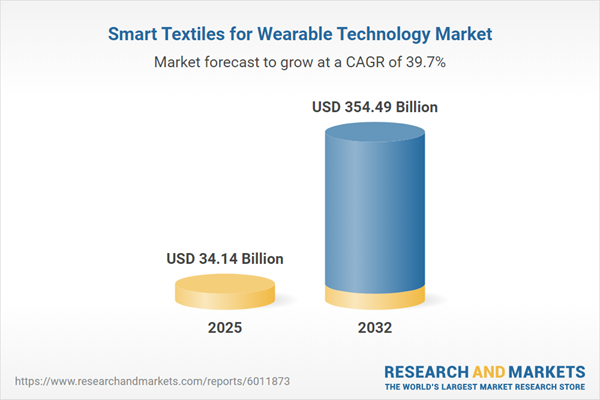Speak directly to the analyst to clarify any post sales queries you may have.
The smart textiles for wearable technology market is rapidly evolving, driven by major technological innovations and surging global demand across industries. Senior decision-makers are increasingly looking to smart textiles as strategic assets that deliver value in healthcare, defense, sports performance, and beyond, reshaping how wearable technology interfaces with users and ecosystems.
Market Snapshot: Growth Trajectory and Strategic Context
The smart textiles for wearable technology market grew from USD 24.42 billion in 2024 to USD 34.14 billion in 2025, and is projected to maintain robust expansion at a CAGR of 39.71%, reaching USD 354.49 billion by 2032.
This explosive growth reflects accelerating adoption in advanced manufacturing, healthcare, defense programs, and consumer-driven segments. Industry innovators are leveraging advances in fiber engineering, embedded sensors, and data analytics to convert traditional textiles into highly functional, responsive platforms that support continuous monitoring and interaction with users.Scope & Segmentation
This report provides comprehensive insights into the market’s structure, regional dynamics, and technological landscape. Key segmentation areas include:
- Type: Active Smart Textiles, Passive Smart Textiles, Ultra-Smart Textiles
- Material Types: Conductive Textiles, Phase Change Materials (PCM), Piezoelectric Materials, Shape Memory Materials
- Application Areas: Fashion & Entertainment, Healthcare & Medical, Industrial & Occupational Safety, Military & Defense, Sports & Fitness
- Geographic Regions: Americas (including United States, Canada, Mexico, Brazil, Argentina, Chile, Colombia, Peru), Europe, Middle East & Africa (including United Kingdom, Germany, France, Russia, Italy, Spain, Netherlands, Sweden, Poland, Switzerland, United Arab Emirates, Saudi Arabia, Qatar, Turkey, Israel, South Africa, Nigeria, Egypt, Kenya), Asia-Pacific (including China, India, Japan, Australia, South Korea, Indonesia, Thailand, Malaysia, Singapore, Taiwan)
- Key Companies: AIQ Smart Clothing Inc., Celanese Corporation, Elitac Wearables, Embro GmbH, H.B. Fuller Company, HeiQ Materials AG, Interactive Wear AG, Jacquard by Google LLC, Nextiles, Inc., Outlast Technologies GmbH
Key Takeaways for Senior Decision-Makers
- Strategic partnerships between textile manufacturers and technology companies are accelerating innovation and shortening product development cycles across the smart textiles sector.
- Major advances in microelectronics, flexible substrates, and low-power communication protocols now enable the integration of autonomous biometric and environmental monitoring solutions into everyday garments and equipment.
- Rising demand for personalized health monitoring, immersive entertainment experiences, and adaptive protective gear is driving market expansion beyond traditional consumer segments.
- Global regulatory alignment around data privacy, safety, and interoperability standards is enabling broader adoption and market entry, especially in healthcare and defense applications.
- Investment in intellectual property, such as patents covering fiber coatings and energy harvesting modules, is reshaping the competitive landscape and influencing cross-sector collaborations.
- Manufacturers are responding to dynamic market challenges by adopting modular manufacturing and localized supply strategies, enhancing agility in the face of policy shifts and technology advances.
Tariff Impact on the Smart Textiles Supply Chain
Recent United States tariff adjustments in 2025 have led global smart textile suppliers and brands to reevaluate sourcing and production strategies. Increased duties on critical raw materials, including conductive fibers and advanced coatings, have raised input costs and prompted companies to localize manufacturing capabilities. Organizations are also utilizing free trade zones and bonded warehousing, though these approaches may add operational complexity and affect lead times. Sectors where reliability and performance are prioritized, such as medical monitoring and defense, continue to support demand despite higher price points, emphasizing the need for supply chain agility and proactive policy engagement.
Methodology & Data Sources
The findings in this report are grounded in a multi-phase research approach, including extensive desk research, patent and publication analysis, and direct interviews with stakeholders throughout the value chain. Proprietary data sets were triangulated with supply chain mapping and detailed case studies to ensure that both global trends and sector-specific operational realities are represented accurately.
Why This Report Matters to Senior Decision-Makers
- Enables leaders to benchmark organizational strategies against global best practices and competitor successes in smart textiles for wearable technology.
- Guides investment and innovation decisions by clarifying how regulatory trends, manufacturing localization, and evolving user demands will shape future market opportunities.
Conclusion
The smart textiles for wearable technology sector stands at a pivotal point, with emerging technologies transforming value chains and end-user experiences across industries. Effective navigation of these shifts requires strategic planning grounded in comprehensive, actionable intelligence.
Additional Product Information:
- Purchase of this report includes 1 year online access with quarterly updates.
- This report can be updated on request. Please contact our Customer Experience team using the Ask a Question widget on our website.
Table of Contents
3. Executive Summary
4. Market Overview
7. Cumulative Impact of Artificial Intelligence 2025
Companies Mentioned
The companies profiled in this Smart Textiles for Wearable Technology market report include:- AIQ Smart Clothing Inc.
- Celanese Corporation
- Elitac Wearables
- Embro GmbH
- H.B. Fuller Company
- HeiQ Materials AG
- Interactive Wear AG
- Jacquard by Google LLC
- Nextiles, Inc.
- Outlast Technologies GmbH
Table Information
| Report Attribute | Details |
|---|---|
| No. of Pages | 189 |
| Published | November 2025 |
| Forecast Period | 2025 - 2032 |
| Estimated Market Value ( USD | $ 34.14 Billion |
| Forecasted Market Value ( USD | $ 354.49 Billion |
| Compound Annual Growth Rate | 39.7% |
| Regions Covered | Global |
| No. of Companies Mentioned | 11 |









